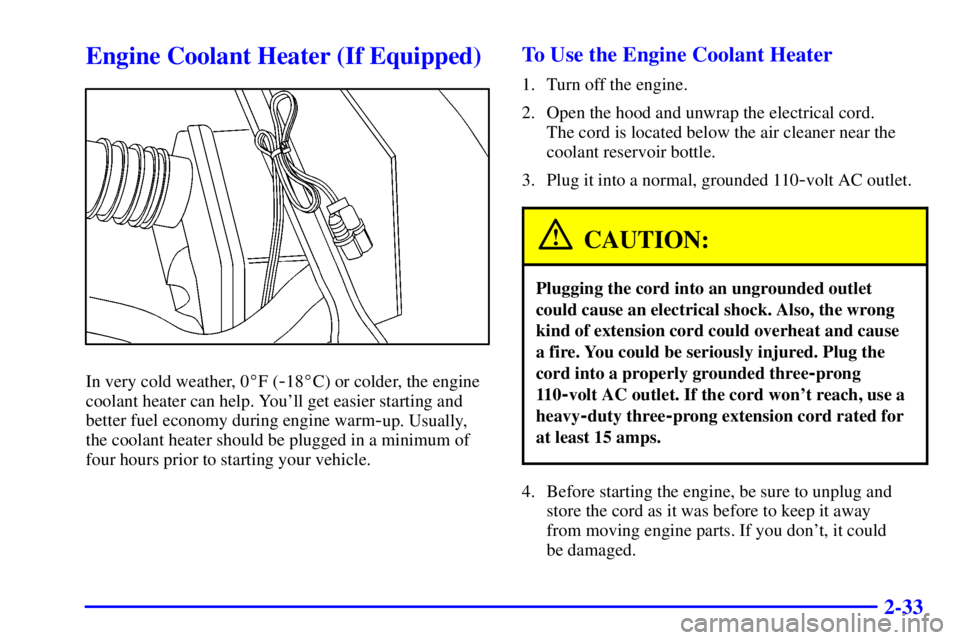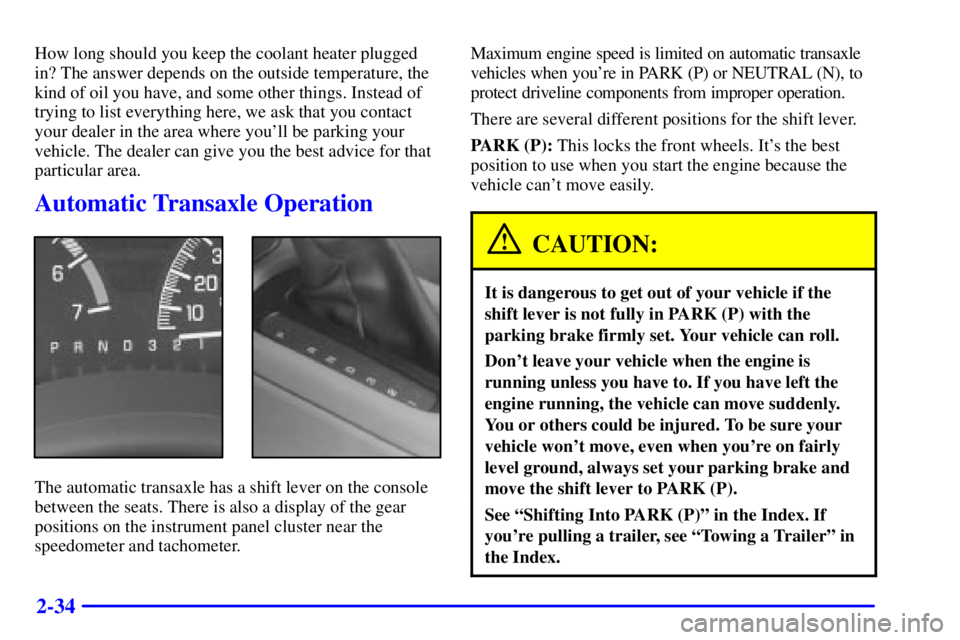Page 11 of 376
ix
For example,
these symbols
are used on an
original battery:
CAUTION
POSSIBLE
INJURY
PROTECT
EYES BY
SHIELDING
CAUSTIC
BATTERY
ACID COULD
CAUSE
BURNS
AVOID
SPARKS OR
FLAMES
SPARK OR
FLAME
COULD
EXPLODE
BATTERY
These symbols
are important
for you and
your passengers
whenever your
vehicle is
driven:
DOOR LOCK
UNLOCK
FASTEN
SEAT
BELTS
POWER
WINDOW
AIR BAG
These symbols
have to do with
your lamps:
MASTER
LIGHTING
SWITCH
TURN
SIGNALS
PARKING
LAMPS
HAZARD
WARNING
FLASHER
DAYTIME
RUNNING
LAMPS
FOG LAMPS
These symbols
are on some of
your controls:
WINDSHIELD
WIPER
WINDSHIELD
WASHER
WINDSHIELD
DEFROSTER
REAR
WINDOW
DEFOGGER
VENTILATING
FAN
These symbols
are used on
warning and
indicator lights:
ENGINE
COOLANT
TEMP
BATTERY
CHARGING
SYSTEM
BRAKE
COOLANT
ENGINE OIL
PRESSURE
ANTI-LOCK
BRAKES
Here are some
other symbols
you may see:
FUSE
LIGHTER
HORN
SPEAKER
FUEL
Vehicle Symbols
These are some of the symbols you may find on your vehicle.
Page 69 of 376

2-
2-1
Section 2 Features and Controls
Here you can learn about the many standard and optional features on your vehicle, and information on starting,
shifting and braking. Also explained are the instrument panel and the warning systems that tell you if everything is
working properly
-- and what to do if you have a problem.
2
-2 Keys
2
-4 Door Locks
2
-7 Keyless Entry System (If Equipped)
2
-12 Multifunction Alarm Locks and
Lighting Choices
2
-23 Trunk
2
-24 Theft
2
-25 Content Theft-Deterrent (If Equipped)
2
-27 PASS-Key� III
2
-29 New Vehicle ªBreak-Inº
2
-29 Ignition Positions
2
-30 Starting Your Engine
2
-33 Engine Coolant Heater (If Equipped)
2
-34 Automatic Transaxle Operation
2
-39 Parking Brake
2
-40 Shifting Into PARK (P)
2
-42 Shifting Out of PARK (P)2
-43 Parking Over Things That Burn
2
-44 Engine Exhaust
2
-44 Running Your Engine While You're Parked
2
-45 Power Windows
2
-47 Turn Signal/Multifunction Lever
2
-52 Exterior Lamps
2
-54 Interior Lamps
2
-57 Mirrors
2
-59 Storage Compartments
2
-64 OnStar� System (If Equipped)
2
-65 Sunroof (If Equipped)
2
-66 The Instrument Panel -- Your
Information System
2
-70 Warning Lights, Gages and Indicators
2
-84 Head-Up Display (Option)
2
-88 Driver Information Center (DIC)
(If Equipped)
2
-90 Trip Computer (If Equipped)
Page 101 of 376

2-33
Engine Coolant Heater (If Equipped)
In very cold weather, 0�F (-18�C) or colder, the engine
coolant heater can help. You'll get easier starting and
better fuel economy during engine warm
-up. Usually,
the coolant heater should be plugged in a minimum of
four hours prior to starting your vehicle.
To Use the Engine Coolant Heater
1. Turn off the engine.
2. Open the hood and unwrap the electrical cord.
The cord is located below the air cleaner near the
coolant reservoir bottle.
3. Plug it into a normal, grounded 110
-volt AC outlet.
CAUTION:
Plugging the cord into an ungrounded outlet
could cause an electrical shock. Also, the wrong
kind of extension cord could overheat and cause
a fire. You could be seriously injured. Plug the
cord into a properly grounded three
-prong
11 0
-volt AC outlet. If the cord won't reach, use a
heavy
-duty three-prong extension cord rated for
at least 15 amps.
4. Before starting the engine, be sure to unplug and
store the cord as it was before to keep it away
from moving engine parts. If you don't, it could
be damaged.
Page 102 of 376

2-34
How long should you keep the coolant heater plugged
in? The answer depends on the outside temperature, the
kind of oil you have, and some other things. Instead of
trying to list everything here, we ask that you contact
your dealer in the area where you'll be parking your
vehicle. The dealer can give you the best advice for that
particular area.
Automatic Transaxle Operation
The automatic transaxle has a shift lever on the console
between the seats. There is also a display of the gear
positions on the instrument panel cluster near the
speedometer and tachometer.Maximum engine speed is limited on automatic transaxle
vehicles when you're in PARK (P) or NEUTRAL (N), to
protect driveline components from improper operation.
There are several different positions for the shift lever.
PARK (P): This locks the front wheels. It's the best
position to use when you start the engine because the
vehicle can't move easily.
CAUTION:
It is dangerous to get out of your vehicle if the
shift lever is not fully in PARK (P) with the
parking brake firmly set. Your vehicle can roll.
Don't leave your vehicle when the engine is
running unless you have to. If you have left the
engine running, the vehicle can move suddenly.
You or others could be injured. To be sure your
vehicle won't move, even when you're on fairly
level ground, always set your parking brake and
move the shift lever to PARK (P).
See ªShifting Into PARK (P)º in the Index. If
you're pulling a trailer, see ªTowing a Trailerº in
the Index.
Page 144 of 376
2-76 Engine Coolant Temperature Light
This light tells you that the
engine coolant has
overheated or the radiator
cooling fan is not working.
If you have been operating the vehicle under normal
driving conditions, you should pull off the road, stop the
vehicle and turn off the engine as soon as possible.
See ªEngine Overheatingº in the Index.
Engine Coolant Temperature Gage
United States Canada
You have a gage that shows the engine coolant
temperature. If the gage pointer moves into the red area,
the engine is too hot!
That reading means the same thing as the warning light.
It means that the engine coolant has overheated. If you
have been operating the vehicle under normal
conditions, you should pull off the road, stop the
vehicle, and turn off the engine as soon as possible.
See ªEngine Overheatingº in the Index.
Page 145 of 376
2-77 Low Coolant Warning Light
If this light comes on,
the system is low on
coolant and the engine
may overheat.
See ªEngine Coolantº in the Index and have the vehicle
serviced as soon as possible.
Malfunction Indicator Lamp
(Service Engine Soon Light)
United States Canada
Your vehicle is equipped with a computer which
monitors operation of the fuel, ignition and emission
control systems.
This system is called OBD II (On
-Board
Diagnostics
-Second Generation) and is intended to
assure that emissions are at acceptable levels for the
life of the vehicle, helping to produce a cleaner
environment. The SERVICE ENGINE SOON light
comes on to indicate that there is a problem and service
is required. Malfunctions often will be indicated by the
system before any problem is apparent. This may
prevent more serious damage to your vehicle. This
system is also designed to assist your service technician
in correctly diagnosing any malfunction.
Page 152 of 376

2-84
Head-Up Display (Option)
CAUTION:
If the HUD image is too bright, or too high in
your field of view, it may take you more time to
see things you need to see when it's dark outside.
Be sure to keep the HUD image dim and placed
low in your field of view.
If you have the Head-Up
Display (HUD), you can see
the speedometer reading
(in English or metric units)
and a brief display of the
current radio station or CD
track, displayed ªthroughº
the windshield.The HUD also shows these lights when they are lit on
the instrument panel cluster:
�Turn Signal Indicators
�High
-Beam Indicator Symbol
�Low Fuel Symbol
The HUD will display ªCHECK GAGEº when the
following items are lit on the instrument panel cluster:
�Oil Warning Symbol
�Coolant Temperature Symbol
�Charging System Symbol
When you sit straight in your seat, the HUD image will
appear straight ahead near the front bumper.
When the ignition key is turned to RUN, the HUD
image will come on. Then the Head
-Up Display will
operate normally.
Page 157 of 376

2-89 Functions
: If one of the doors is ajar, this light will
appear next to that door on the vehicle outline.
CHANGE OIL SOON: This light will appear when the
system indicates that it's time for an oil change. The
system predicts remaining oil life using inputs from
length of drives, coolant temperature, engine rpm and
vehicle speed. It alerts you to change the oil on a
schedule consistent with the vehicle's driving
conditions. After changing the oil, the system must be
reset. See ªHow to Reset the GM Oil Life System�º in
the Index.
LOW: This light will come on when the ignition is
on and the fluid in the washer fluid container is low.
AJAR: This light alerts you that the trunk is not
fully closed.LOW TRAC: This light will come on when the traction
control system is limiting wheel spin. See ªTraction
Control Systemº or ªLow Traction Lightº in the Index.
TRAC OFF: This light lets you know that the traction
control system has been disabled and will not limit
wheel spin. See ªEnhanced Traction System Warning
Lightº or ªLow Traction Lightº in the Index.
TRAC: If the vehicle has the traction control system,
you will have a disable switch on the far right side of the
DIC. The traction control system is automatically
activated when you turn the ignition on. This switch will
activate/deactivate the traction control system. If you
need to disable the system, such as when you are stuck
and are rocking the vehicle back and forth, push this
button. See ªStuck: In Sand, Mud, Ice or Snowº in
the Index.